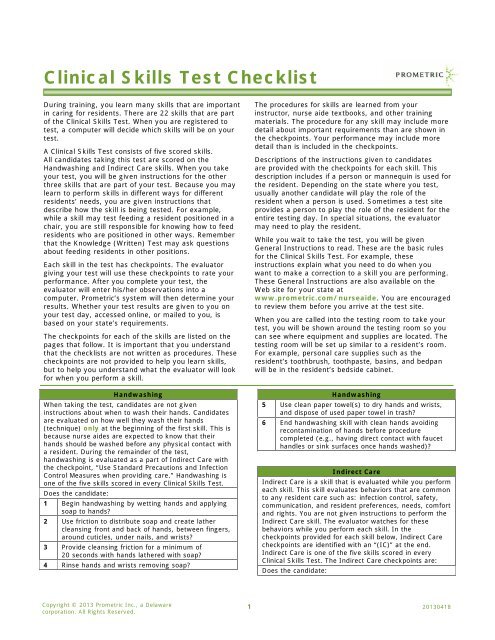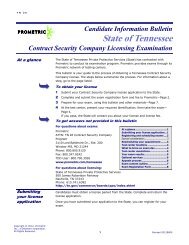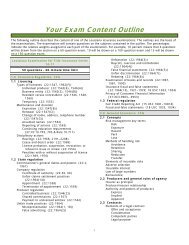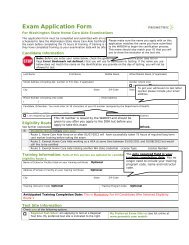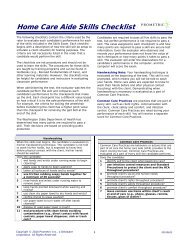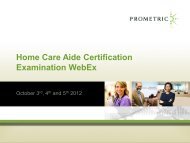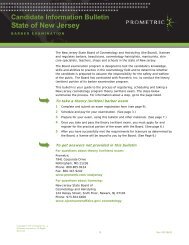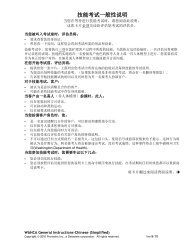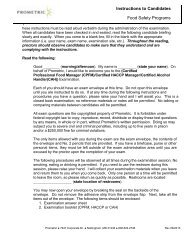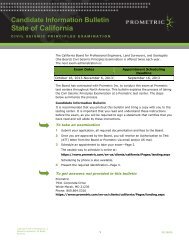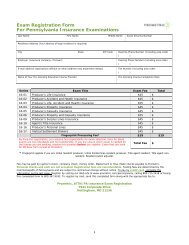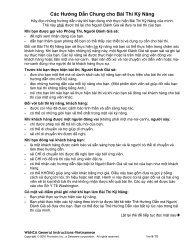Generic Nurse Aide Clinical Skills Checklist - Prometric
Generic Nurse Aide Clinical Skills Checklist - Prometric
Generic Nurse Aide Clinical Skills Checklist - Prometric
Create successful ePaper yourself
Turn your PDF publications into a flip-book with our unique Google optimized e-Paper software.
<strong>Clinical</strong> <strong>Skills</strong> Test <strong>Checklist</strong><br />
During training, you learn many skills that are important<br />
in caring for residents. There are 22 skills that are part<br />
of the <strong>Clinical</strong> <strong>Skills</strong> Test. When you are registered to<br />
test, a computer will decide which skills will be on your<br />
test.<br />
A <strong>Clinical</strong> <strong>Skills</strong> Test consists of five scored skills.<br />
All candidates taking this test are scored on the<br />
Handwashing and Indirect Care skills. When you take<br />
your test, you will be given instructions for the other<br />
three skills that are part of your test. Because you may<br />
learn to perform skills in different ways for different<br />
residents’ needs, you are given instructions that<br />
describe how the skill is being tested. For example,<br />
while a skill may test feeding a resident positioned in a<br />
chair, you are still responsible for knowing how to feed<br />
residents who are positioned in other ways. Remember<br />
that the Knowledge (Written) Test may ask questions<br />
about feeding residents in other positions.<br />
Each skill in the test has checkpoints. The evaluator<br />
giving your test will use these checkpoints to rate your<br />
performance. After you complete your test, the<br />
evaluator will enter his/her observations into a<br />
computer. <strong>Prometric</strong>’s system will then determine your<br />
results. Whether your test results are given to you on<br />
your test day, accessed online, or mailed to you, is<br />
based on your state’s requirements.<br />
The checkpoints for each of the skills are listed on the<br />
pages that follow. It is important that you understand<br />
that the checklists are not written as procedures. These<br />
checkpoints are not provided to help you learn skills,<br />
but to help you understand what the evaluator will look<br />
for when you perform a skill.<br />
Handwashing<br />
When taking the test, candidates are not given<br />
instructions about when to wash their hands. Candidates<br />
are evaluated on how well they wash their hands<br />
(technique) only at the beginning of the first skill. This is<br />
because nurse aides are expected to know that their<br />
hands should be washed before any physical contact with<br />
a resident. During the remainder of the test,<br />
handwashing is evaluated as a part of Indirect Care with<br />
the checkpoint, “Use Standard Precautions and Infection<br />
Control Measures when providing care.” Handwashing is<br />
one of the five skills scored in every <strong>Clinical</strong> <strong>Skills</strong> Test.<br />
Does the candidate:<br />
1 Begin handwashing by wetting hands and applying<br />
soap to hands?<br />
2 Use friction to distribute soap and create lather<br />
cleansing front and back of hands, between fingers,<br />
around cuticles, under nails, and wrists?<br />
3 Provide cleansing friction for a minimum of<br />
20 seconds with hands lathered with soap?<br />
4 Rinse hands and wrists removing soap?<br />
The procedures for skills are learned from your<br />
instructor, nurse aide textbooks, and other training<br />
materials. The procedure for any skill may include more<br />
detail about important requirements than are shown in<br />
the checkpoints. Your performance may include more<br />
detail than is included in the checkpoints.<br />
Descriptions of the instructions given to candidates<br />
are provided with the checkpoints for each skill. This<br />
description includes if a person or mannequin is used for<br />
the resident. Depending on the state where you test,<br />
usually another candidate will play the role of the<br />
resident when a person is used. Sometimes a test site<br />
provides a person to play the role of the resident for the<br />
entire testing day. In special situations, the evaluator<br />
may need to play the resident.<br />
While you wait to take the test, you will be given<br />
General Instructions to read. These are the basic rules<br />
for the <strong>Clinical</strong> <strong>Skills</strong> Test. For example, these<br />
instructions explain what you need to do when you<br />
want to make a correction to a skill you are performing.<br />
These General Instructions are also available on the<br />
Web site for your state at<br />
www.prometric.com/nurseaide. You are encouraged<br />
to review them before you arrive at the test site.<br />
When you are called into the testing room to take your<br />
test, you will be shown around the testing room so you<br />
can see where equipment and supplies are located. The<br />
testing room will be set up similar to a resident’s room.<br />
For example, personal care supplies such as the<br />
resident’s toothbrush, toothpaste, basins, and bedpan<br />
will be in the resident’s bedside cabinet.<br />
Handwashing<br />
5 Use clean paper towel(s) to dry hands and wrists,<br />
and dispose of used paper towel in trash?<br />
6 End handwashing skill with clean hands avoiding<br />
recontamination of hands before procedure<br />
completed (e.g., having direct contact with faucet<br />
handles or sink surfaces once hands washed)?<br />
Indirect Care<br />
Indirect Care is a skill that is evaluated while you perform<br />
each skill. This skill evaluates behaviors that are common<br />
to any resident care such as: infection control, safety,<br />
communication, and resident preferences, needs, comfort<br />
and rights. You are not given instructions to perform the<br />
Indirect Care skill. The evaluator watches for these<br />
behaviors while you perform each skill. In the<br />
checkpoints provided for each skill below, Indirect Care<br />
checkpoints are identified with an “(IC)” at the end.<br />
Indirect Care is one of the five skills scored in every<br />
<strong>Clinical</strong> <strong>Skills</strong> Test. The Indirect Care checkpoints are:<br />
Does the candidate:<br />
Copyright © 2013 <strong>Prometric</strong> Inc., a Delaware<br />
corporation. All Rights Reserved.<br />
1 20130418
CLINICAL SKILLS TEST CHECKLIST<br />
Indirect Care<br />
1 Greet resident, address by name, and introduce<br />
self? (IC)<br />
2 Provide explanations to resident about care before<br />
beginning and during care? (IC)<br />
3 Ask resident about preferences during care? (IC)<br />
4 Use Standard Precautions and infection control<br />
measures when providing care? (IC)<br />
5 Ask resident about comfort or needs during care or<br />
before care completed? (IC)<br />
6 Promote resident’s rights during care? (IC)<br />
7 Promote resident’s safety during care? (IC)<br />
Ambulate the resident using a transfer/gait belt<br />
The candidate is asked to walk a resident who needs<br />
some assistance to stand. A transfer/gait belt is used<br />
while walking the resident. The role of the resident is<br />
played by a person.<br />
Does the candidate:<br />
1 Greet resident, address by name and introduce self?<br />
(IC)<br />
2 Provide explanations to resident about care before<br />
beginning and during care? (IC)<br />
3 Apply transfer/gait belt before standing resident,<br />
placing around the resident’s waist and over<br />
clothing, secure so that only flat fingers/hand fit<br />
under belt, and the belt does not catch skin or skin<br />
folds (e.g. breast tissue)?<br />
4 Provide signal or cue to resident before assisting to<br />
stand?<br />
5 Assist resident to stand while holding onto the<br />
transfer/gait belt without holding belt only at the<br />
front or only at nearest side (if assisting to stand<br />
from the side)?<br />
6 Ask about how resident feels upon standing?<br />
7 Walk resident while standing to the side and slightly<br />
behind resident?<br />
8 Provide support while walking resident with an arm<br />
around resident’s back holding transfer/gait belt?<br />
9 Ask about how resident feels during ambulation?<br />
10 Walk resident at least 10 steps?<br />
11 Assist resident to turn and have back of legs<br />
positioned against the seat of chair before resident<br />
sits?<br />
12 Provide support to sit resident back into chair?<br />
13 Remove transfer/gait belt from resident’s waist<br />
without harming resident (e.g., pulling transfer/gait<br />
belt) when seated in chair after ambulation?<br />
14 Maintain own body mechanics when assisting<br />
resident to stand and sit?<br />
15 Leave resident positioned in chair in proper body<br />
alignment and hips against back of seat?<br />
16 Ask resident about preferences during care? (IC)<br />
17 Use Standard Precautions and infection control<br />
measures when providing care? (IC)<br />
Ambulate the resident using a transfer/gait belt<br />
18 Ask resident about comfort or needs during care or<br />
before care completed? (IC)<br />
19 Promote resident’s rights during care? (IC)<br />
20 Promote resident’s safety during care? (IC)<br />
Assist resident needing to use a bedpan<br />
The candidate is asked to help a resident who has asked<br />
for a bedpan. The role of the resident is played by a<br />
person who will be wearing a hospital-style gown over<br />
clothing. For the purposes of testing, the candidate will<br />
pretend that the resident (actor) is not wearing<br />
underpants.<br />
Does the candidate:<br />
1 Greet resident, address by name and introduce self?<br />
(IC)<br />
2 Provide explanations to resident about care before<br />
beginning and during care? (IC)<br />
3 Place protective pad on bed over bottom sheet,<br />
under buttocks/upper thigh area, before placing<br />
bedpan, and remove the pad after bedpan is<br />
removed?<br />
4 Place and remove bedpan by either having resident<br />
positioned on side to turn on/off back, onto/off<br />
bedpan, or having resident raise hips off bed?<br />
5 Position bedpan under resident according to<br />
form/shape of the selected bedpan?<br />
6 Position bedpan to allow for collection?<br />
7 Raise the head of the bed after positioning the<br />
resident on the bedpan, and lower the head of the<br />
bed before removing bedpan?<br />
8 Ask resident to call when finished or if needs help,<br />
leaving call light within the resident’s reach before<br />
leaving resident to use bedpan?<br />
9 Leave toilet paper within resident's reach before<br />
leaving resident to use bedpan?<br />
10 Wear gloves when removing bedpan and while<br />
emptying and cleaning bedpan?<br />
11 Empty contents of bedpan into toilet, rinse bedpan<br />
pouring contents into toilet, and dry bedpan?<br />
12 Offer resident damp washcloth or paper towel, or<br />
hand wipe, to cleanse hands after bedpan used,<br />
before end of care?<br />
13 Complete skill storing bedpan and toilet paper,<br />
placing soiled linens in hamper, and disposing of<br />
trash?<br />
14 Keep resident positioned a safe distance from the<br />
edge of the bed at all times?<br />
15 Ask resident about preferences during care? (IC)<br />
16 Use Standard Precautions and infection control<br />
measures when providing care? (IC)<br />
17 Ask resident about comfort or needs during care or<br />
before care completed? (IC)<br />
18 Promote resident’s rights during care? (IC)<br />
19 Promote resident’s safety during care? (IC)<br />
20130418 2
CLINICAL SKILLS TEST CHECKLIST<br />
Change bed linen while the resident remains in bed<br />
The candidate is asked to change the top and bottom<br />
sheets and pillow case on the bed while the resident<br />
stays in the bed. The role of the resident is played by a<br />
person.<br />
Does the candidate:<br />
1 Greet resident, address by name and introduce self?<br />
(IC)<br />
2 Provide explanations to resident about care before<br />
beginning and during care? (IC)<br />
3 Keep resident positioned a safe distance from the<br />
edge of the bed at all times?<br />
4 Remove and replace bottom sheet on one side of<br />
the bed, before turning resident to remove and<br />
replace sheet on the other side of the bed?<br />
5 Keep resident positioned on a bottom sheet<br />
throughout procedure?<br />
6 Secure bottom sheet to mattress (e.g., for fitted<br />
sheet secure over all four corners of the mattress;<br />
for flat sheet, tuck at head of bed and on sides and<br />
extend toward bottom of mattress so that resident’s<br />
heels are not against any exposed mattress)?<br />
7 Leave bottom sheet free of creases or folds?<br />
8 Turn or position resident to remove or replace<br />
sheet(s) without pulling sheets in a manner that<br />
creates friction and risks skin shearing?<br />
9 Replace the top sheet over resident with a clean<br />
sheet?<br />
10 Tuck top sheet under foot of mattress leaving sheet<br />
placed loosely, avoiding pressure against toes and<br />
allowing for foot movement?<br />
11 Leave top sheet placed on top of resident to cover<br />
body up to shoulder level, without tucking in along<br />
sides?<br />
12 Keep pillow positioned under resident’s head<br />
throughout and at the end of the procedure, except<br />
when removed briefly to replace pillowcase?<br />
13 Complete procedure with resident positioned<br />
between the top and bottom sheet?<br />
14 Complete skill placing soiled linens in hamper and<br />
disposing of trash?<br />
15 Ask resident about preferences during care? (IC)<br />
16 Use Standard Precautions and infection control<br />
measures when providing care? (IC)<br />
17 Ask resident about comfort or needs during care or<br />
before care completed? (IC)<br />
18 Promote resident’s rights during care? (IC)<br />
19 Promote resident’s safety during care? (IC)<br />
Change resident’s position to a<br />
supported side-lying position<br />
The candidate is asked to change the position of a<br />
resident who is lying on his/her back, to a side-lying<br />
position. The resident requires support to remain<br />
positioned on the side. The role of the resident is played<br />
by a person.<br />
Does the candidate:<br />
Change resident’s position to a<br />
supported side-lying position<br />
1 Greet resident, address by name, and introduce<br />
self? (IC)<br />
2 Provide explanations to resident about care before<br />
beginning and during care? (IC)<br />
3 Assist resident with turning onto side before placing<br />
positioning devices?<br />
4 Keep resident positioned a safe distance from the<br />
edge of the bed at all times?<br />
5 Use positioning device/padding or pillow under or<br />
against resident’s back that maintains side-lying<br />
position?<br />
6 Leave resident positioned on side with upper knee<br />
bent in front of the lower leg?<br />
7 Support resident’s top leg by placing device(s)/<br />
padding or pillow(s) between legs?<br />
8 Position device(s)/padding or pillow(s) placed<br />
between legs so that bony prominences of the<br />
knees and ankles are separated?<br />
9 Leave the resident positioned on side without lying<br />
on the shoulder, arm, and hand?<br />
10 Leave pillow placed under head positioned to also<br />
support the resident’s neck and chin?<br />
11 Place device/padding or pillow positioned to support<br />
the resident’s upper arm, supporting both the<br />
shoulder and arm?<br />
12 Ask resident about preferences during care? (IC)<br />
13 Use Standard Precautions and infection control<br />
measures when providing care? (IC)<br />
14 Ask resident about comfort or needs during care or<br />
before care completed? (IC)<br />
15 Promote resident’s rights during care? (IC)<br />
16 Promote resident’s safety during care? (IC)<br />
Dress a resident who has a weak arm<br />
The candidate is asked to put a long-sleeved shirt, pants,<br />
and socks or a resident who is lying in bed. The resident<br />
is not able to help with the dressing and has a weak arm.<br />
A person will play the role of the resident.<br />
Does the candidate:<br />
1 Greet resident, address by name, and introduce<br />
self? (IC)<br />
2 Provide explanations to resident about care before<br />
beginning and during care? (IC)<br />
3 Include resident in decision-making about clothing<br />
to wear?<br />
4 Collect all garments before removing hospital gown?<br />
5 Support affected right arm while undressing and<br />
dressing?<br />
6 Remove hospital gown?<br />
7 Dress affected right arm first?<br />
8 Gather up sleeve to ease pulling over affected arm?<br />
9 Dress resident by putting on pants, shirt with<br />
sleeves, and socks?<br />
3 20130418
CLINICAL SKILLS TEST CHECKLIST<br />
Dress a resident who has a weak arm<br />
10 Move resident’s extremities gently without overextension<br />
or force when undressing and dressing?<br />
11 Apply clothing correctly (e.g. front of shirt in front),<br />
adjust clothing for comfort, neatness, alignment,<br />
and close fasteners?<br />
12 Place dirty gown in hamper?<br />
13 Ask resident about preferences during care? (IC)<br />
14 Keep resident positioned a safe distance from the<br />
edge of the bed at all times?<br />
15 Use Standard Precautions and infection control<br />
measures when providing care? (IC)<br />
16 Ask resident about comfort or needs during care or<br />
before care completed? (IC)<br />
17 Promote resident’s rights during care? (IC)<br />
18 Promote resident’s safety during care? (IC)<br />
Empty contents of resident’s urinary drainage bag,<br />
and measure and record urine output on an<br />
Intake and Output (I&O) form<br />
The candidate is asked to empty the resident’s urinary<br />
drainage bag into a graduate container and to measure<br />
the amount of urine. An Intake and Output (I&O) Form<br />
(see sample on website) is provided to record the<br />
measurement. The output should be recorded as urine<br />
and the correct time recorded for the measurement. The<br />
role of the resident will be played by either a person or<br />
mannequin.<br />
Does the candidate:<br />
1 Greet resident, address by name, and introduce<br />
self? (IC)<br />
2 Provide explanations to resident about care<br />
before beginning and during care? (IC)<br />
3 Wear gloves while handling the urinary drainage<br />
bag, graduate, and bedpan (if used), and remove<br />
gloves before documenting I&O?<br />
4 Set graduate or bedpan on barrier placed on<br />
floor and empty full contents of drainage bag into<br />
the graduate or bedpan?<br />
5 Empty contents of urinary drainage bag without<br />
contaminating drainage tube (e.g., touching<br />
container) and close and protect drain (e.g.,<br />
clamp and tuck drain into pocket) after emptying<br />
drainage bag?<br />
6 Set graduate on flat surface protected with<br />
barrier to read, obtaining measurement by<br />
reading graduate at eye level, and if urine<br />
poured into graduate from a bedpan, complete<br />
task over toilet pouring the full amount of urine<br />
into the graduate?<br />
7 Empty urine in graduate into toilet after<br />
measuring, rinse and dry container, pouring rinse<br />
water into toilet?<br />
8 Record output with clean hands?<br />
9 Record output within +/- 50cc's of nurse’s<br />
measurement?<br />
Empty contents of resident’s urinary drainage bag,<br />
and measure and record urine output on an<br />
Intake and Output (I&O) form<br />
10 Record output as urine and indicate the correct<br />
time on the I&O form?<br />
11 Leave bag hanging from bed frame (not side<br />
rail), and drainage bag and tubing off (not<br />
touching) the floor?<br />
12 Keep urinary drainage bag positioned lower than<br />
bladder throughout care?<br />
13 Complete skill having stored equipment, placing<br />
soiled linens in hamper, and disposing of trash?<br />
14 Ask resident about preferences during care? (IC)<br />
15 Use Standard Precautions and infection control<br />
measures when providing care? (IC)<br />
16 Ask resident about comfort or needs during care<br />
or before care completed? (IC)<br />
17 Promote resident’s rights during care? (IC)<br />
18 Promote resident’s safety during care? (IC)<br />
Feed a resident who is sitting in a chair<br />
The candidate is asked to feed a snack to a resident who<br />
is not able to feed him/herself. The resident is sitting in a<br />
chair. A Food and Fluid Intake Form (sample provided on<br />
the website) is provided to record the resident’s<br />
estimated food and fluid intake. The role of the resident<br />
is played by a person.<br />
Does the candidate:<br />
1 Greet resident, address by name, and introduce<br />
self? (IC)<br />
2 Provide explanations to resident about care before<br />
beginning and during care? (IC)<br />
3 Assist or cue resident to sit upright in chair before<br />
feeding?<br />
4 Offer and assist resident to wash hands before<br />
feeding using a damp washcloth, paper towel, or<br />
hand wipe?<br />
5 Sit while feeding the resident?<br />
6 Offer to protect resident’s clothing with a barrier<br />
before feeding, and if used, remove barrier at end<br />
of feeding?<br />
7 Use spoon to feed?<br />
8 Offer fluids to drink throughout feeding; at least<br />
every 2-3 bites of food?<br />
9 Allow resident the opportunity to swallow before<br />
feeding the next bite?<br />
10 Converse with resident during meal<br />
(e.g., encourage intake)?<br />
11 Leave area around resident’s mouth clean and dry<br />
when care completed?<br />
12 Complete skill placing any used linen in hamper,<br />
disposing of trash, and leaving overbed table dry?<br />
13 Record the amount of the resident’s food intake on<br />
the Food and Fluid Intake Form within 25% of the<br />
nurse’s measurement?<br />
20130418 4
CLINICAL SKILLS TEST CHECKLIST<br />
Feed a resident who is sitting in a chair<br />
14 Record the amount of the resident’s fluid intake on<br />
the Food and Fluid Intake Form within 25% of the<br />
nurse’s measurement?<br />
15 Ask resident about preferences during care? (IC)<br />
16 Use Standard Precautions and infection control<br />
measures when providing care? (IC)<br />
17 Ask resident about comfort or needs during care or<br />
before care completed? (IC)<br />
18 Promote resident’s rights during care? (IC)<br />
19 Promote resident’s safety during care? (IC)<br />
Measure and record a resident’s radial pulse<br />
The candidate is asked to take the resident’s radial pulse,<br />
measured at the wrist. The pulse should be counted for<br />
one full minute. A Measurement Form (sample provided<br />
on the website) is provided to record the resident’s pulse<br />
rate. The role of the resident is played by a person.<br />
Does the candidate:<br />
1 Greet resident, address by name, and introduce<br />
self? (IC)<br />
2 Provide explanations to resident about care before<br />
beginning and during care? (IC)<br />
3 Support resident’s arm in manner to avoid dangling<br />
while pulse is taken?<br />
4 Use fingers (not thumb) to take pulse?<br />
5 Places fingers on wrist at radial pulse to measure<br />
pulse rate?<br />
6 Count pulse for one full minute?<br />
7 Record resident’s pulse rate on Measurement Form<br />
within +/- 4 beats per minute of nurse’s<br />
measurement?<br />
8 Ask resident about preferences during care? (IC)<br />
9 Use Standard Precautions and infection control<br />
measures when providing care? (IC)<br />
10 Ask resident about comfort or needs during care or<br />
before care completed? (IC)<br />
11 Promote resident’s rights during care? (IC)<br />
12 Promote resident’s safety during care? (IC)<br />
Measure and record a resident’s respirations<br />
The candidate is asked to count the resident’s<br />
respirations. The respirations should be counted for one<br />
full minute. A Measurement Form (sample provided on<br />
the website) is provided to record the resident’s<br />
respiration rate. The role of the resident is played by a<br />
person.<br />
Does the candidate:<br />
1 Greet resident, address by name, and introduce<br />
self? (IC)<br />
2 Provide explanations to resident about care before<br />
beginning and during care? (IC)<br />
3 Measure rate of respirations without providing<br />
instructions to resident about how to breathe?<br />
Measure and record a resident’s respirations<br />
4 Count respirations for one full minute?<br />
5 Record resident’s respiration rate on Measurement<br />
Form within +/- 2 breaths per minute of nurse’s<br />
measurement?<br />
6 Ask resident about preferences during care? (IC)<br />
7 Use Standard Precautions and infection control<br />
measures when providing care? (IC)<br />
8 Ask resident about comfort or needs during care or<br />
before care completed? (IC)<br />
9 Promote resident’s rights during care? (IC)<br />
10 Promote resident’s safety during care? (IC)<br />
Provide catheter care to a female resident who has<br />
an indwelling urinary catheter<br />
The candidate is asked to provide catheter care to a<br />
female resident who has an indwelling urinary catheter.<br />
Soap and water should be used for the catheter care. For<br />
testing purposes, only the cleansing of the front perineal<br />
area and catheter are evaluated; cleansing of the rectal<br />
and buttocks is not tested in this skill. A mannequin is<br />
used for the role of the resident.<br />
Does the candidate:<br />
1 Greet resident, address by name, and introduce<br />
self? (IC)<br />
2 Provide explanations to resident about care before<br />
beginning and during care? (IC)<br />
3 Wear gloves while providing catheter care, cleaning<br />
equipment, and handling soiled underpads,<br />
washcloths, and towels?<br />
4 Position towel or underpad under buttocks/thigh<br />
area before cleansing, and when care completed<br />
remove towel or underpad, or leave resident on a<br />
dry underpad?<br />
5 Use water of safe temperature for washing and<br />
rinsing?<br />
6 Use soapy washcloth to clean inside labia?<br />
7 Change spot on soapy washcloth for each washing<br />
stroke, wiping from front to back when cleansing<br />
inside labia?<br />
8 Cleanse catheter using clean area of washcloth,<br />
washing away from body and down the catheter at<br />
least 3-4 inches?<br />
9 Use clean soap-free wet washcloth to remove soap?<br />
10 Change spot on washcloth for each rinsing stroke,<br />
wiping front to back inside labia, and away from<br />
body when rinsing catheter?<br />
11 Dry perineal area, from front to back after<br />
completing cleansing and rinsing?<br />
12 Leave tubing free of kinks or obstructions, and keep<br />
tubing and urinary drainage bag off floor?<br />
13 Keep urinary drainage bag positioned lower than<br />
bladder throughout procedure?<br />
14 Complete skill having rinsed, dried and stored<br />
basin, placing soiled linens in hamper, disposing of<br />
trash, and leaving overbed table dry?<br />
5 20130418
CLINICAL SKILLS TEST CHECKLIST<br />
Provide catheter care to a female resident who has<br />
an indwelling urinary catheter<br />
15 Keep resident positioned a safe distance from the<br />
edge of the bed at all times?<br />
16 Ask resident about preferences during care? (IC)<br />
17 Use Standard Precautions and infection control<br />
measures when providing care? (IC)<br />
18 Ask resident about comfort or needs during care or<br />
before care completed? (IC)<br />
19 Promote resident’s rights during care? (IC)<br />
20 Promote resident’s safety during care? (IC)<br />
Provide foot care to a resident who is<br />
sitting in a chair<br />
The candidate is asked to provide foot care to a resident.<br />
Soap and water is used and foot care is provided to only<br />
one foot. The resident is sitting in a chair. The resident’s<br />
sock and shoe are replaced at the end of the skill. The<br />
resident role is played by a person.<br />
Does the candidate:<br />
1 Greet resident, address by name and introduce self?<br />
(IC)<br />
2 Provide explanations to resident about care before<br />
beginning and during care? (IC)<br />
3 Place water filled basin on protective barrier on floor<br />
to prepare for foot care?<br />
4 Use water of safe temperature for soaking foot?<br />
5 Soak resident’s foot in basin of water?<br />
6 Use soapy washcloth to wash foot without adding<br />
soap directly to basin of water?<br />
7 Wash top and bottom of foot and between toes?<br />
8 Remove soap from foot including between toes?<br />
9 Dry entire top and bottom of foot including between<br />
toes?<br />
10 Warm lotion before applying to foot (e.g., warming<br />
in hands, placing bottle in warm water)?<br />
11 Apply lotion to top and bottom of foot, excluding<br />
between toes?<br />
12 Remove visible excess lotion from foot if present<br />
after applying?<br />
13 Apply sock to foot leaving sock smooth, and replace<br />
shoe; leaving any fasteners, such as ties, secured?<br />
14 Provide support to lower extremity throughout<br />
procedure as needed to avoid strain?<br />
15 Avoid placing resident’s barefoot directly on floor<br />
before, during or after foot care?<br />
16 Complete skill having rinsed, dried and stored<br />
basin, placing soiled linens in hamper, and<br />
disposing of trash?<br />
17 Ask resident about preferences during care? (IC)<br />
18 Use Standard Precautions and infection control<br />
measures when providing care? (IC)<br />
19 Ask resident about comfort or needs during care or<br />
before care completed? (IC)<br />
20 Promote resident’s rights during care? (IC)<br />
Provide foot care to a resident who is<br />
sitting in a chair<br />
21 Promote resident’s safety during care? (IC)<br />
Provide mouth care to a resident<br />
who has a denture<br />
A resident is sitting at an overbed table and the<br />
resident’s denture is in a denture cup. The resident’s<br />
denture needs to be cleaned and the resident needs<br />
mouth care. The role of the resident is played by a<br />
person.<br />
Does the candidate:<br />
1 Greet resident, address by name and introduce self?<br />
(IC)<br />
2 Provide explanations to resident about care before<br />
beginning and during care? (IC)<br />
3 Wear gloves when handling denture, providing<br />
mouth care, and rinsing equipment?<br />
4 Protect denture from damage while cleaning by<br />
lining sink, filling sink with water, or holding<br />
denture directly over basin?<br />
5 Protect denture from contamination (e.g., use a<br />
barrier when setting denture on surfaces, avoid<br />
placing or rinsing denture in sink water)?<br />
6 Use cool or tepid running water to clean and rinse<br />
denture?<br />
7 Brush all surfaces of the denture using a toothbrush<br />
or denture brush with toothpaste?<br />
8 Rinse denture to remove toothpaste?<br />
9 Handle clean denture maintaining cleanliness after<br />
brushed, placing denture in denture cup filled with<br />
clean cool or tepid water?<br />
10 Leave denture cup on resident’s bedside cabinet or<br />
overbed table unless following resident’s preference<br />
about where denture cup should be stored?<br />
11 Protect resident’s clothing before providing mouth<br />
care and remove protective cover when care is<br />
completed?<br />
12 Provide mouth care cleaning upper and lower gums,<br />
using moistened foam-tipped applicator or<br />
toothbrush, and toothpaste on toothbrush or<br />
applicator (if does not have cleansing agent)?<br />
13 Offer resident cup of water to rinse mouth after<br />
mouth care?<br />
14 Provide emesis basin or disposable cup to resident<br />
to use for spitting as needed?<br />
15 Leave area around resident’s mouth clean and dry<br />
when care is completed?<br />
16 Complete skill having rinsed, dried and stored basin<br />
(if used), emptying sink of water and removing<br />
barrier from sink (if used), placing soiled linens in<br />
hamper, disposing of trash, and leaving overbed<br />
table dry?<br />
17 Ask resident about preferences during care? (IC)<br />
18 Use Standard Precautions and infection control<br />
measures when providing care? (IC)<br />
20130418 6
CLINICAL SKILLS TEST CHECKLIST<br />
Provide mouth care to a resident<br />
who has a denture<br />
19 Ask resident about comfort or needs during care or<br />
before care completed? (IC)<br />
20 Promote resident’s rights during care? (IC)<br />
21 Promote resident’s safety during care? (IC)<br />
Provide mouth care to a resident who has teeth<br />
A resident who has his/her natural teeth is lying in bed<br />
and needs mouth care. The role of the resident is played<br />
by a person.<br />
Does the candidate:<br />
1 Greet resident, address by name, and introduce<br />
self? (IC)<br />
2 Provide explanations to resident about care before<br />
beginning and during care? (IC)<br />
3 Assist resident to sitting position in bed by raising<br />
HOB and using pillows as needed to position<br />
resident upright at 60° to 90° before offering fluid<br />
or brushing teeth?<br />
4 Protect resident’s clothing before providing mouth<br />
care and remove protective cover when care<br />
completed?<br />
5 Moisten toothbrush with water and apply toothpaste<br />
before brushing teeth?<br />
6 Wear gloves when brushing resident’s teeth and<br />
wear throughout mouth care including when rinsing<br />
basin and toothbrush?<br />
7 Brush sides and biting surfaces of teeth and the<br />
gum line with a gentle motion?<br />
8 Offer resident cup of water to rinse mouth after<br />
brushing?<br />
9 Provide resident an emesis basin or disposable cup<br />
to use for spitting as needed, such as after rinsing<br />
mouth?<br />
10 Leave area around resident’s mouth clean and dry<br />
when care completed?<br />
11 Complete skill having rinsed, dried and stored<br />
basin, placing soiled linens in hamper, disposing of<br />
trash, and leaving overbed table dry?<br />
12 Ask resident about preferences during care? (IC)<br />
13 Use Standard Precautions and infection control<br />
measures when providing care? (IC)<br />
14 Ask resident about comfort or needs during care or<br />
before care completed? (IC)<br />
15 Promote resident’s rights during care? (IC)<br />
16 Promote resident’s safety during care? (IC)<br />
Provide perineal care to a female resident<br />
who is incontinent of urine<br />
The candidate is asked to provide perineal care to a<br />
resident who is incontinent of urine. The resident is lying<br />
in bed on an underpad and is wearing a hospital-style<br />
gown that is dry. A mannequin is used for the role of the<br />
resident.<br />
Provide perineal care to a female resident<br />
who is incontinent of urine<br />
Does the candidate:<br />
1 Greet resident, address by name and introduce self?<br />
(IC)<br />
2 Provide explanations to resident about care before<br />
beginning and during care? (IC)<br />
3 Wear gloves while providing perineal care, cleaning<br />
equipment, and handling soiled underpads,<br />
washcloths and towels?<br />
4 Remove soiled underpad and replace with dry<br />
underpad before beginning cleansing?<br />
5 Use water of safe temperature for washing and<br />
rinsing?<br />
6 Use soapy washcloth to wash front perineum to<br />
include genital and skin fold areas of groin?<br />
7 Change spot on washcloth for washing and rinsing<br />
strokes when cleansing inside the vulva?<br />
8 Wipe from front to back with all washing and rinsing<br />
strokes when cleansing the front perineum, to<br />
include the genital and skin fold areas of groin?<br />
9 Use clean, soap-free, wet washcloth to remove soap<br />
from resident’s skin on front perineum?<br />
10 Dry front perineum after washed and rinsed, using<br />
towel to pat dry, moving from front to back?<br />
11 Replace water in basin during care if it becomes<br />
cold or soapy?<br />
12 Position resident on side to prepare for cleansing of<br />
buttocks and rectal area?<br />
13 Wash, rinse, and dry buttocks and rectal area?<br />
14 Wipe from front to back with all washing and rinsing<br />
strokes when cleansing the rectal area?<br />
15 Leave resident on dry underpad at completion of<br />
procedure?<br />
16 Complete skill having rinsed, dried and stored<br />
basin, placing soiled linens in hamper, disposing of<br />
trash, and leaving overbed table dry?<br />
17 Keep resident positioned a safe distance from the<br />
edge of the bed at all times?<br />
18 Ask resident about preferences during care? (IC)<br />
19 Use Standard Precautions and infection control<br />
measures when providing care? (IC)<br />
20 Ask resident about comfort or needs during care or<br />
before care completed? (IC)<br />
21 Promote resident’s rights during care? (IC)<br />
22 Promote resident’s safety during care? (IC)<br />
Provide resident hand and nail care<br />
The candidate is asked to provide hand and nail care to<br />
one hand. The role of the resident is played by a person.<br />
Does the candidate:<br />
1 Greet resident, address by name, and introduce<br />
self? (IC)<br />
2 Provide explanations to resident about care before<br />
beginning and during care? (IC)<br />
7 20130418
CLINICAL SKILLS TEST CHECKLIST<br />
Provide resident hand and nail care<br />
3 Use water of safe temperature for soaking fingers<br />
or hand?<br />
4 Place fingers or full hand into basin of water to soak<br />
before removing residue from under nails?<br />
5 Clean hand surfaces using wet washcloth, cleaning<br />
between fingers, and if soap used, rinse or remove<br />
soap using a clean, soap-free, wet washcloth?<br />
6 Use flat edge of orangewood stick to remove<br />
residue under tips of each fingernail, and remove<br />
residue from edge of orangewood stick, if present,<br />
before using again to clean under another<br />
fingernail?<br />
7 Rest resident’s hand on barrier such as a dry towel<br />
once removed from basin while providing nail and<br />
hand care?<br />
8 Dry hand before completing care?<br />
9 Leave nails smooth (e.g., free of jagged edges)?<br />
10 Apply lotion to cleaned hand after nail care<br />
finished?<br />
11 Support resident’s arm if raised off table when<br />
providing nail and hand care?<br />
12 Remove visible excess lotion from hand if present at<br />
completion of hand care?<br />
13 Complete skill having rinsed, dried and stored<br />
basin, placing soiled linens in hamper, disposing of<br />
trash, and leaving overbed table dry?<br />
14 Ask resident about preferences during care? (IC)<br />
15 Use Standard Precautions and infection control<br />
measures when providing care? (IC)<br />
16 Ask resident about comfort or needs during care or<br />
before care completed? (IC)<br />
17 Promote resident’s rights during care? (IC)<br />
18 Promote resident’s safety during care? (IC)<br />
Provide resident a partial bed bath and back rub<br />
The candidate is asked to bathe a resident who is in bed<br />
and who is not able to help with his/her bathing. For<br />
testing purposes only, the candidate is asked to wash<br />
just part of the body so that technique can be evaluated.<br />
Instructions ask the candidate to wash the resident’s<br />
face, neck, back, one hand and arm, and one side of the<br />
chest and abdomen. Soap and water should be used for<br />
the bathing. The resident also needs a back rub. When<br />
completing the skill, the mannequin is dressed in a clean<br />
hospital-style gown. A mannequin is used for the role of<br />
the resident.<br />
Does the candidate:<br />
1 Greet resident, address by name and introduce self?<br />
(IC)<br />
2 Provide explanations to resident about care before<br />
beginning and during care? (IC)<br />
3 Use water of safe temperature for washing and<br />
rinsing?<br />
Provide resident a partial bed bath and back rub<br />
4 Cleanse eyes by using soap-free washcloth wiping<br />
eye from the inside corner to the outside corner,<br />
changing to clean area of washcloth before<br />
returning to inner corner and before cleansing the<br />
other eye?<br />
5 Wash resident’s face using a soap-free wet<br />
washcloth, unless ascertains resident’s preference<br />
to use soap before washing face?<br />
6 Leave face dry after washing?<br />
7 Contain corners of washcloth while washing and<br />
rinsing (e.g., forming mitt)?<br />
8 Protect bed linen from becoming wet during<br />
washing and rinsing of body (non-face)?<br />
9 Wash resident’s body (non-face) using a wet<br />
washcloth with small amount of soap?<br />
10 Use clean, soap-free, wet washcloth to remove soap<br />
from resident’s skin?<br />
11 Wash and rinse resident’s neck, hand, arm, chest,<br />
and abdomen?<br />
12 Dry neck, hand, arm, chest, and abdomen?<br />
13 Support arm if raised off bed to wash, rinse, and<br />
dry the back side of arm?<br />
14 Assist resident to turn onto side before cleansing<br />
back?<br />
15 Wash, rinse, and dry back?<br />
16 Replace basin of water during task if it becomes<br />
cold or soapy?<br />
17 Warm lotion before applying to resident’s back<br />
(e.g., warming in hands, placing bottle in warm<br />
water)?<br />
18 Use lotion to provide back rub with long gliding and<br />
circular motions?<br />
19 Place clean hospital gown on resident and secure<br />
gown in back?<br />
20 Complete skill having rinsed, dried and stored<br />
basin, placing soiled linens in hamper, disposing of<br />
trash, and leaving overbed table dry?<br />
21 Keep resident positioned a safe distance from the<br />
edge of the bed at all times?<br />
22 Ask resident about preferences during care? (IC)<br />
23 Use Standard Precautions and infection control<br />
measures when providing care? (IC)<br />
24 Ask resident about comfort or needs during care or<br />
before care completed? (IC)<br />
25 Promote resident’s rights during care? (IC)<br />
26 Promote resident’s safety during care? (IC)<br />
20130418 8
CLINICAL SKILLS TEST CHECKLIST<br />
Provide resident with passive range of motion<br />
(ROM) exercises to one elbow and wrist<br />
The candidate is asked to provide range of motion<br />
exercise to a resident who is not able to help with the<br />
exercises. The resident needs his/her elbow flexed and<br />
extended, and the wrist flexed and hyperextended. For<br />
testing purposes, the resident needs three repetitions of<br />
both exercises. The instructions provided at the test site<br />
will indicate whether the exercise is to the left or right<br />
side. The role of the resident is played by a person.<br />
Does the candidate:<br />
1 Greet resident, address by name, and introduce<br />
self? (IC)<br />
2 Provide explanations to resident about care before<br />
beginning and during care? (IC)<br />
3 Exercise correct joints and correct side when<br />
performing range of motion (ROM)?<br />
4 Support extremity to protect the working joint<br />
throughout ROM exercises?<br />
5 Bend and straighten arm at elbow through ROM<br />
(flexion/extension)?<br />
6 Move wrist through ROM by bending wrist to move<br />
hand down and back (flexion and hyperextension)?<br />
7 Ask resident to report discomfort during ROM or ask<br />
if resident has discomfort during ROM exercises?<br />
8 Control extremity throughout ROM exercises<br />
providing smooth, slow, non-forceful movement?<br />
9 Ask resident about preferences during care? (IC)<br />
10 Use Standard Precautions and infection control<br />
measures when providing care? (IC)<br />
11 Ask resident about comfort or needs during care or<br />
before care completed? (IC)<br />
12 Promote resident’s rights during care? (IC)<br />
13 Promote resident’s safety during care? (IC)<br />
Provide resident with passive range of motion<br />
(ROM) exercises to one shoulder<br />
The candidate is asked to provide range of motion<br />
exercise to a resident who is not able to help with the<br />
exercises. The resident needs his/her shoulder flexed and<br />
extended, and abducted and adducted. For testing<br />
purposes, the resident needs three repetitions of both<br />
exercises. The instructions provided at the test site will<br />
indicate whether the exercise is to the left or right side.<br />
The role of the resident is played by a person.<br />
Does the candidate:<br />
1 Greet resident, address by name, and introduce<br />
self? (IC)<br />
2 Provide explanations to resident about care before<br />
beginning and during care? (IC)<br />
3 Exercise correct joint and correct side when<br />
performing range of motion (ROM)?<br />
4 Support extremity to protect the working joint<br />
throughout ROM exercises?<br />
5 Move shoulder through ROM, raising and lowering<br />
arm along side, toward head of bed (HOB) and back<br />
to mattress (flexion/extension)?<br />
Provide resident with passive range of motion<br />
(ROM) exercises to one shoulder<br />
6 Move resident’s shoulder through ROM taking arm<br />
away from side and back to side (abduction/<br />
adduction)?<br />
7 Ask resident to report discomfort during ROM or<br />
ask if resident has discomfort during ROM<br />
exercises?<br />
8 Control extremity throughout ROM exercises<br />
providing smooth, slow, non-forceful movement?<br />
9 Ask resident about preferences during care? (IC)<br />
10 Use Standard Precautions and infection control<br />
measures when providing care? (IC)<br />
11 Ask resident about comfort or needs during care or<br />
before care completed? (IC)<br />
12 Promote resident’s rights during care? (IC)<br />
13 Promote resident’s safety during care? (IC)<br />
Provide resident with passive range of motion<br />
(ROM) exercises to one hip, knee and ankle<br />
The candidate is asked to provide range of motion<br />
exercise to a resident who is not able to help with the<br />
exercises. The resident needs his/her hip and knee flexed<br />
and extended, and the dorsiflexion and plantar flexion to<br />
the ankle. For testing purposes, the resident needs three<br />
repetitions of both exercises. The instructions provided at<br />
the test site will indicate whether the exercise is to the<br />
left or right side. The role of the resident is played by a<br />
person.<br />
Does the candidate:<br />
1 Greet resident, address by name, and introduce<br />
self? (IC)<br />
2 Provide explanations to resident about care before<br />
beginning and during care? (IC)<br />
3 Exercise correct joints and correct side when<br />
performing range of motion (ROM)?<br />
4 Support extremity to protect the working joint<br />
throughout ROM exercises?<br />
5 Move resident’s hip and knee through ROM, flexing<br />
knee and hip, raising toward torso and returning<br />
back to mattress (flexion/extension)?<br />
6 Support extremity to prevent heel friction against<br />
mattress during ROM exercises?<br />
7 Move resident’s foot up toward head and point<br />
down toward the mattress through ROM<br />
(dorsiflexion/plantar flexion)?<br />
8 Ask resident to report discomfort during ROM or<br />
ask if resident has discomfort during ROM<br />
exercises?<br />
9 Control extremity throughout ROM exercises<br />
providing smooth, slow, non-forceful movement?<br />
10 Ask resident about preferences during care? (IC)<br />
11 Use Standard Precautions and infection control<br />
measures when providing care? (IC)<br />
12 Ask resident about comfort or needs during care or<br />
before care completed? (IC)<br />
13 Promote resident’s rights during care? (IC)<br />
9 20130418
CLINICAL SKILLS TEST CHECKLIST<br />
Provide resident with passive range of motion<br />
(ROM) exercises to one hip, knee and ankle<br />
14 Promote resident’s safety during care? (IC)<br />
Transfer the resident from the bed into a<br />
wheelchair using a pivot technique and a<br />
transfer/gait belt<br />
The candidate is asked to transfer a resident who is lying<br />
in bed, into a wheelchair. A pivot transfer technique is<br />
required and a transfer/gait belt is required. The resident<br />
is able to stand but cannot take steps. The role of the<br />
resident is played by a person.<br />
Does the candidate:<br />
1 Greet resident, address by name and introduce self?<br />
(IC)<br />
2 Provide explanations to resident about care before<br />
beginning and during care? (IC)<br />
3 Place wheelchair near resident’s bed before<br />
assisting resident to sit at edge of bed?<br />
4 Move wheelchair footrests out of the way before<br />
standing resident for transfer (e.g., lift, swing, or<br />
remove)?<br />
5 Place nonskid footwear (e.g., shoes) on resident<br />
before standing resident for transfer?<br />
6 Provide support to assist resident to sitting position<br />
on side of bed, without pulling resident by lower<br />
arms or hands?<br />
7 Provide resident opportunity to sit on side of bed to<br />
adjust to change in position before beginning<br />
transfer?<br />
8 Position resident’s feet flat on the floor before<br />
standing to begin transfer?<br />
9 Prepare for transfer by positioning wheelchair with<br />
front interior wheel close enough to bed so that<br />
transfer can be completed as a pivot?<br />
10 Lock wheelchair before standing resident to begin<br />
transfer?<br />
11 Apply transfer/gait belt before standing resident,<br />
placing around the resident’s waist and over<br />
clothing, secured so that only flat fingers/hand fit<br />
under belt, and the belt does not catch skin or skin<br />
folds (e.g. breast tissue)?<br />
12 Provide cue or signal to resident before assisting to<br />
stand?<br />
13 Stand in front of resident reaching under resident’s<br />
arms to hold transfer/gait belt at sides or around<br />
back throughout transfer?<br />
14 Brace one or both of resident’s legs during transfer<br />
while assisting to stand, turn, and sit?<br />
15 Maintain own body mechanics when assisting<br />
resident to stand, turn, and sit?<br />
16 Transfer resident as a pivot completed without<br />
having resident take step(s) to reach wheelchair,<br />
and before assisting resident to sit in wheelchair,<br />
positions with the back of resident’s legs against<br />
the seat of wheelchair?<br />
Transfer the resident from the bed into a<br />
wheelchair using a pivot technique and a<br />
transfer/gait belt<br />
17 Support resident to provide for controlled gentle<br />
lowering into seat of wheelchair?<br />
18 Leave resident positioned in wheelchair in proper<br />
body alignment, hips against back of seat, and feet<br />
on footrests?<br />
19 Remove transfer/gait belt from resident’s waist<br />
without harming resident (e.g., pulling transfer/gait<br />
belt) when transfer is complete?<br />
20 Ask resident about preferences during care? (IC)<br />
21 Use Standard Precautions and infection control<br />
measures when providing care? (IC)<br />
22 Ask resident about comfort or needs during care or<br />
before care completed? (IC)<br />
23 Promote resident’s rights during care? (IC)<br />
24 Promote resident’s safety during care? (IC)<br />
20130418 10


